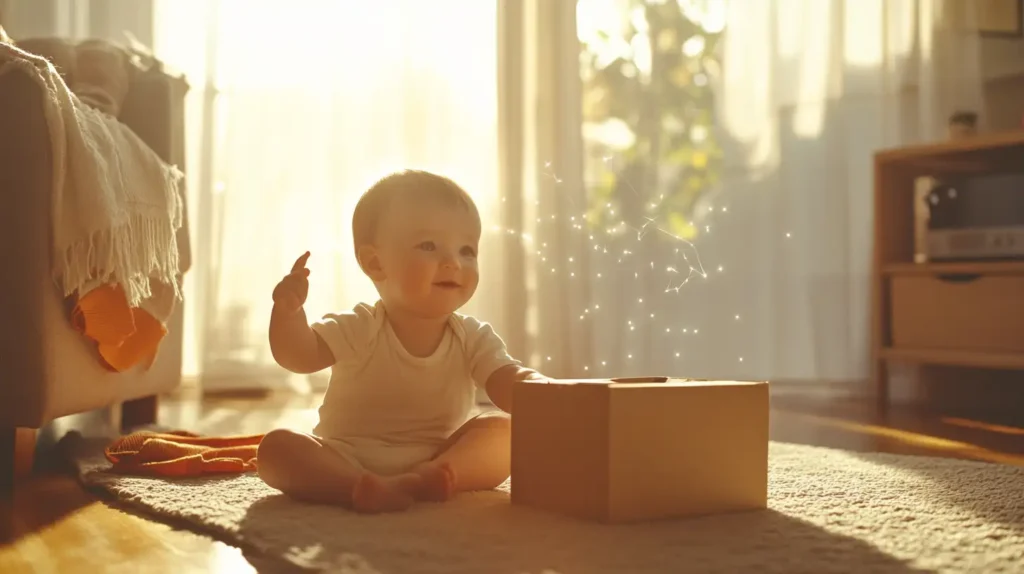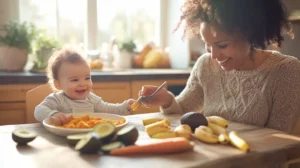Table of Contents
ToggleUnlock Your Baby’s Mind: 5 Minutes a Day of Budget-Friendly Sensory Magic
This may sound crazy, but the secret to your baby’s brain development isn’t what you think. Have you ever felt that the more expensive toys you buy, the less interested your little one seems to be? Maybe you’ve watched them ignore that educational light-up toy to play with the cardboard box instead. In this article, I’m going to share with you something I really wish I learned sooner as a new parent.
I shared this with a sleep-deprived mom friend over coffee who desperately wanted to provide enriching experiences for her 6-month-old without breaking the bank. She so badly wanted to stop feeling guilty about not buying all those fancy developmental toys and start making changes that would help her baby thrive without emptying her wallet.
Let me explain how this works. I used to overthink everything about baby development. Every milestone, every sensory experience, every educational opportunity. And I thought if I just spent more money on specialized toys, attended more baby classes, and created Pinterest-perfect sensory bins, my baby would be more advanced. But in reality, caring too much about perfection was just holding us both back from enjoying simple, meaningful play.
So I made a change in our daily routine, and it made me more confident as a parent. I stopped caring about having Instagram-worthy sensory activities. I stopped caring about buying specialized equipment. I stopped caring about what other parents might think of our hodgepodge DIY approach. And really, all this changed everything for us. My baby was happier, I was less stressed, and our connection grew stronger through these simple activities.
Because here’s the biggest mistake most parents make: We think by spending more money and creating elaborate setups, that will make our babies smarter. We believe that if we just invest enough in the right products, our children will have an advantage. But what I’m saying here is that you should try using what you already have at home, and if you’re satisfied with how your baby engages and explores, the price tag is irrelevant. You showed up and created a meaningful experience—that’s what matters most.
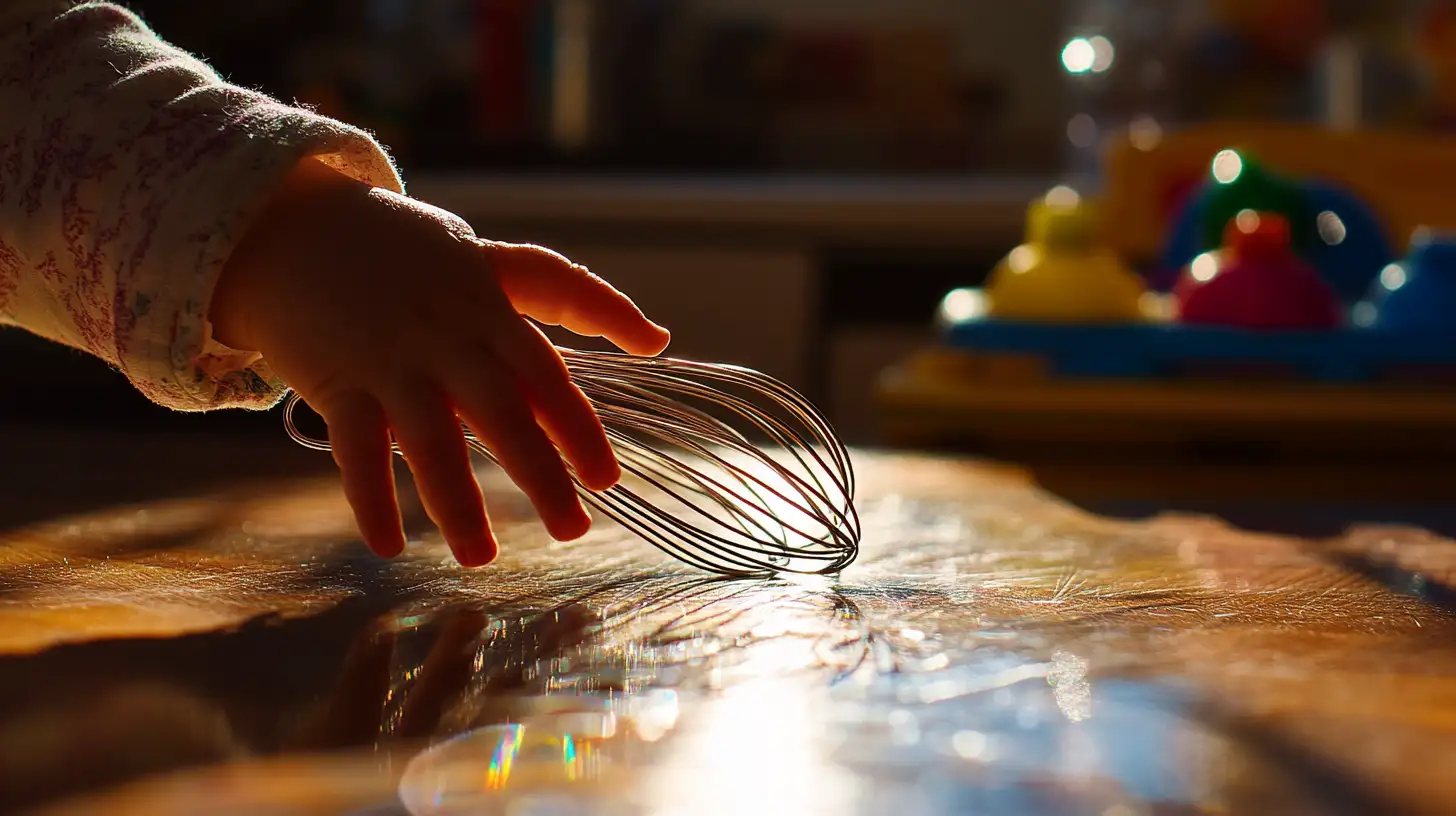
The Magic of Everyday Objects: Sensory Play Basics
Before we dive into specific activities, let’s understand what sensory play actually means. It’s any activity that stimulates your baby’s senses: touch, smell, taste, sight, hearing, and movement. And the beautiful thing? The most effective sensory tools are probably already sitting in your kitchen cabinets or linen closet.
I remember when my baby was just 4 months old, I spent hours researching the best sensory toys only to find her completely mesmerized by a simple kitchen whisk I was using to make pancakes one morning. The way the light filtered through the metal wires, creating shadows and reflections, captivated her more than any toy I’d purchased.
That’s when it clicked for me—babies don’t need fancy equipment. They’re naturally wired to learn through exploration, and everyday objects provide the perfect opportunity for this discovery. A wooden spoon becomes a drum, a plastic container transforms into a sorting box, and a scarf turns into a peek-a-boo game. These simple items engage multiple senses simultaneously, creating rich neural connections in your baby’s developing brain.
When you embrace this approach, you’ll notice that sensory play becomes less about buying things and more about seeing your home through your baby’s curious eyes. That shift in perspective is liberating—for both your creativity and your wallet.
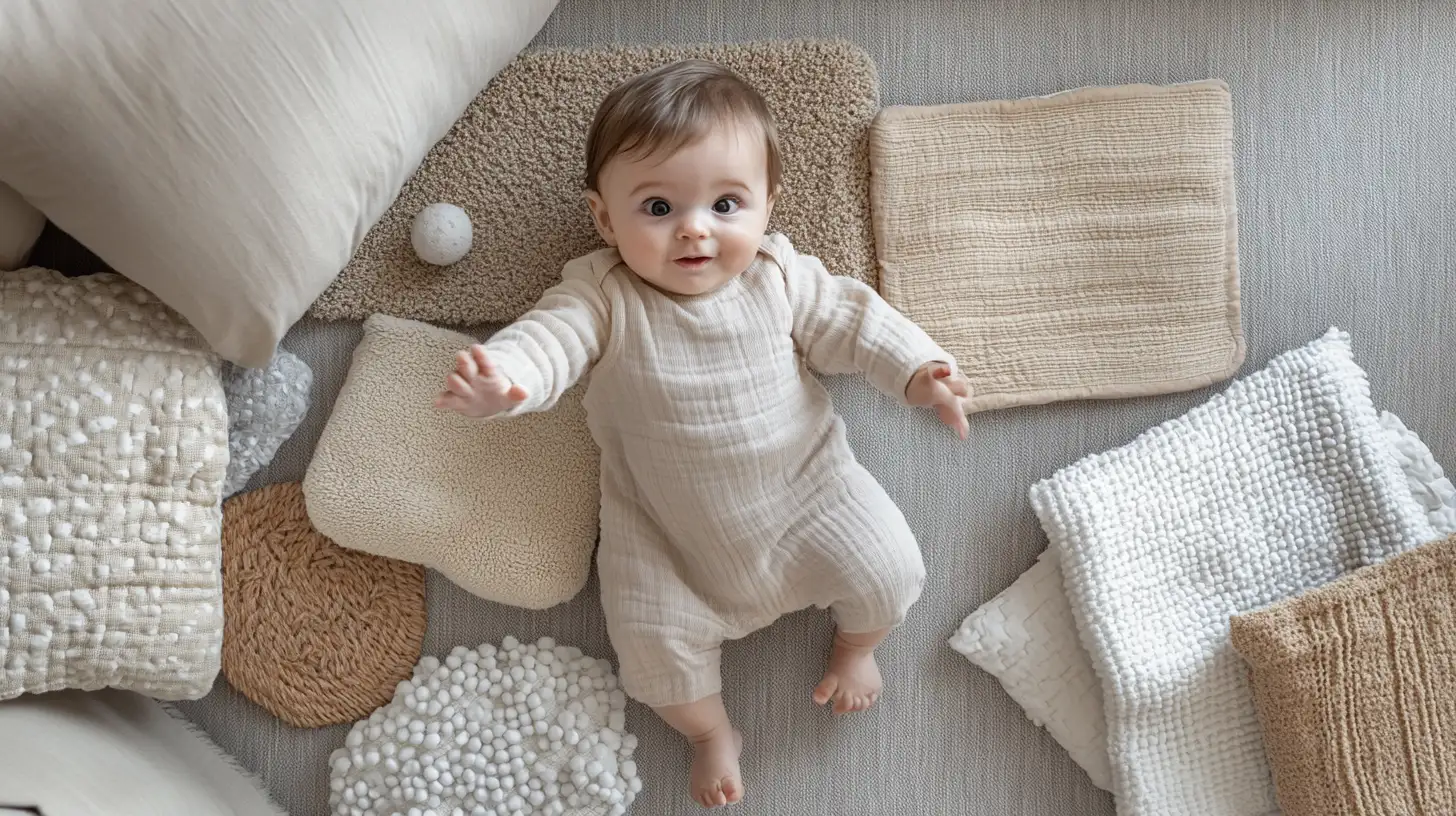
Touch and Feel: Texture Adventures for Tiny Fingers
The sense of touch is perhaps the most developed sense at birth, making texture exploration a perfect starting point for sensory play. In my home country, we say likkle pickney learn with dem hands first—little children learn first with their hands. And it’s absolutely true!
For babies 0-6 months:
- Create a texture board using fabric scraps from old clothes—smooth satin, rough burlap, soft fleece, bumpy terrycloth. Secure different swatches to a piece of cardboard with non-toxic glue or stitching.
- Fill clean socks with different materials—rice, beans, crinkly paper—and securely sew the ends for safe exploration.
- Freeze a small amount of breast milk or formula in an ice cube tray, then place in a sealed ziplock bag for a cold sensory experience during tummy time.
For babies 6-12 months:
- Create edible fingerpaint using plain yogurt mixed with a drop of food coloring for mess-free art exploration.
- Fill a plastic container with cooked and cooled spaghetti for a squidgy, wriggly sensory bin.
- Make a mystery box from a shoebox—cut a hand-sized hole and place different textured items inside for your baby to reach in and discover.
For babies 12+ months:
- Create a sensory bin with dried beans, rice, or pasta (always supervised) with measuring cups and spoons for scooping practice.
- Make cloud dough by mixing 8 parts flour with 1 part vegetable oil for a moldable, soft sensory experience.
- Collect nature items like smooth stones, pine cones, and leaves for a natural texture exploration tray.
I remember creating a simple texture path on our living room floor using different fabrics—my baby would crawl from silky scarves to rough welcome mats, giggling with each new sensation under her hands and knees. These experiences cost nothing but created priceless moments of joy and discovery.

See and Discover: Visual Stimulation Without the Price Tag
Visual stimulation is crucial for your baby’s developing brain, but you don’t need fancy black-and-white cards or light-up toys to provide it. The key is contrast, movement, and novelty—all of which can be created with items you already own.
For babies 0-6 months:
- Create a DIY mobile using high-contrast cardstock—cut simple shapes like circles, triangles, and stars in black and white and hang them above the changing table.
- Make a sunshine bottle by filling a clear plastic bottle with water and a few drops of baby oil, then add sequins or small buttons (securely sealed) for a mesmerizing visual tracking exercise.
- Use a flashlight to create moving shadows on the wall during evening routines.
For babies 6-12 months:
- Create color sorting games using laundry basket lids and colored socks or washcloths.
- Make a peek-a-boo board from an old cereal box—cut flaps that open to reveal family photos or colorful magazine pictures.
- Fill clear containers with colored water for pouring experiments in the bathtub or on a towel outdoors.
For babies 12+ months:
- Create a light table using a clear plastic storage container with string lights placed underneath (supervised activity).
- Make color-mixing bags by placing primary-colored paints in ziplock bags, taping securely, and letting your baby squish the colors together.
- Create a discovery basket with interesting household items that vary in shape and color—a whisk, measuring spoons, colorful fabric swatches.
One evening, when the electricity went out during a storm, I was worried my baby would be frightened. Instead, I found a flashlight and created animal shadows with my hands on the wall. The look of wonder on her face as she watched those simple shadows dance across the room reminded me that sometimes, the unexpected, uncomplicated moments create the most powerful learning experiences.
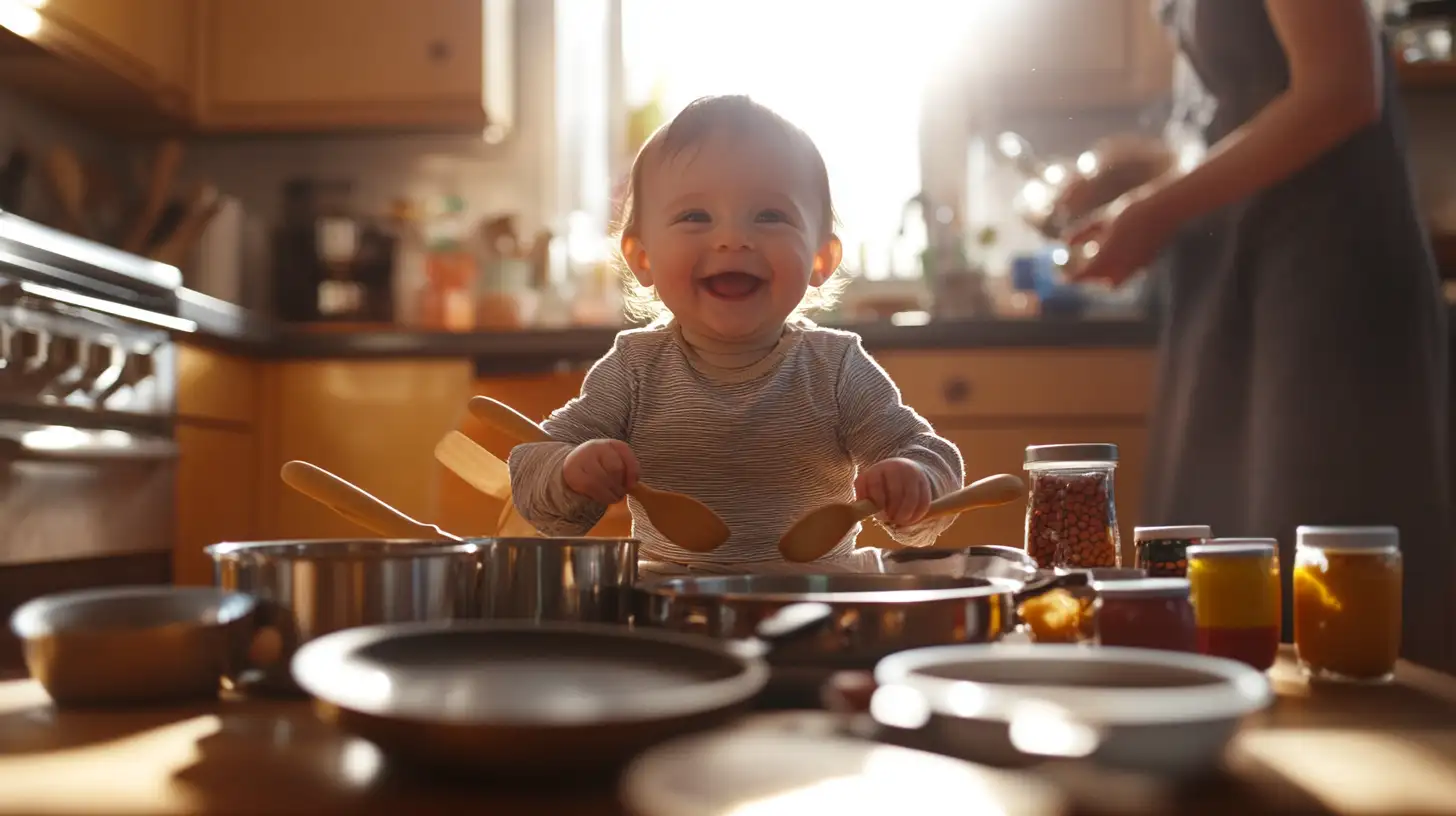
Sound and Rhythm: Musical Explorations from Your Kitchen
In my home, music flows as naturally as the Caribbean breeze, and you don’t need specialized instruments to introduce your baby to the world of sound. The kitchen is actually the best music store you’ll ever visit!
For babies 0-6 months:
- Create rattles using clean, empty spice containers filled with different materials—rice, beans, pasta—each creating a unique sound.
- Make a rain stick from a paper towel roll—insert crumpled aluminum foil, add a handful of rice or beans, and secure the ends for a soothing sound experience.
- Use different voices when talking to your baby—high, low, whispered, sung—to develop auditory discrimination.
For babies 6-12 months:
- Create a drum set using upturned pots and pans with wooden spoons as drumsticks.
- Make shakers by placing beans or rice in clean yogurt containers, securing the lids with tape, and decorating the outside.
- Fill glasses with different levels of water and gently tap with a spoon to create different tones.
For babies 12+ months:
- Create a sound matching game—make two of each type of shaker and help your baby find the matching sounds.
- Make string instruments using rubber bands stretched over empty tissue boxes.
- Create rhythm patterns by clapping, tapping, or using simple homemade instruments, encouraging your baby to imitate.
I’ll never forget the afternoon I was preparing dinner, feeling guilty that I wasn’t doing a proper activity with my baby. In frustration, I handed her a wooden spoon and an empty pot while I continued cooking. Within minutes, she had discovered a symphony of sounds—tapping the pot, the floor, the refrigerator door—each surface creating a different tone. Her face lit up with each new discovery, and I realized that I didn’t need to orchestrate every learning moment. Sometimes, the best sensory experiences emerge naturally from everyday life.

Taste and Smell: Sensory Feasts for Tiny Explorers
As parents from the islands, we know that spices and foods aren’t just nourishment—they’re part of our cultural heritage and powerful sensory tools. Introducing your baby to diverse smells and tastes (when developmentally appropriate) creates neural pathways that may foster adventurous eating habits later on.
For babies 0-6 months (primarily for smell, following pediatrician guidance for taste):
- Create smell jars using cotton balls lightly scented with safe, familiar smells—vanilla extract, cinnamon, orange peel—and place in securely closed containers with holes in the lids.
- Use different essential oils on washcloths during bath time for aromatic exploration (always diluted and baby-safe oils).
- Wear different natural scents while holding your baby—flowers from your garden, citrus fruit after cooking, or herbs from your kitchen.
For babies 6-12 months (always following pediatric guidance for food introduction):
- Create taste exploration with small amounts of developmentally appropriate foods with different flavors—avocado (smooth), banana (sweet), yogurt (tangy).
- Make scented play dough using flour, salt, water, and food extracts like vanilla or coconut.
- Create scent matching games with herbs from your kitchen—put small amounts in closed containers and help baby match the pairs.
For babies 12+ months:
- Make taste exploration plates with small amounts of contrasting but safe foods—sweet (banana), salty (soft cheese), sour (small bite of orange), savory (avocado).
- Create herb and spice painting—mix safe spices like cinnamon or turmeric with a little water for scented finger painting.
- Make sensory soup in the bathtub using floating herbs like lavender or mint for a scented water play experience.
One of my favorite memories is watching my baby experience the smell of fresh mangoes for the first time. I was cutting fruit in the kitchen while she sat in her high chair, and I noticed her nose twitching as the sweet aroma filled the air. I brought the mango closer for her to smell, and her eyes widened with wonder. Now, whenever we cut mangoes, she gets excited—that neural connection between smell and pleasure firmly established through that simple, everyday moment.
Embracing the Journey: Beyond Baby Sensory Activities
The best high performers, the best athletes, and the best parents that I know, they care, but they’re not attached to perfection. So they show up, they give their best with what they have, and then they let go. Because they know if they’ve done everything they can with the resources available, they’ve already won. And so have you.
I think it’s time that we all embrace this with what we have energy in parenting. The feeling that you’re going ahead no matter what your budget, your space limitations, or your craft skills. This mindset helps you to show up more confident with every single step of your parenting journey.
This really brings me to this next point of you finally asserting that you are enough as a parent. What I learned about overcoming my perfectionism in creating sensory experiences is that perfectionism isn’t about trying to create perfect activities—it’s about never feeling like what you’re providing is good enough. So for me to overcome this, I had to understand and fully embrace that my attention and presence were more valuable than any store-bought sensory toy.
So when I stopped procrastinating on embracing my own sensory play ideas because they weren’t Pinterest-perfect, everything changed. I created water play with just a plastic container and a cup. I introduced texture exploration with the different fabrics in our laundry basket. And I started our music sensory journey with nothing but kitchen utensils and my own voice.
Because here is the most powerful thing in parenting: when you embrace your progress as a parent versus trying to achieve a picture-perfect result that you envisioned, you will achieve more connection and development than you ever thought possible. Knowing that what you have is enough, and that you are enough for your baby.
By taking that next step forward in sensory play without knowing exactly how it will end, but really just trusting in the process of exploration together—that is the secret to successful development. And this really brings me to the point that this fear of judgment from other parents, the anxiety about whether you’re providing enough enrichment—they are really just stories that you’re telling yourself.
Because at the end of the day, your baby doesn’t care if that sensory bin came from an educational store or your kitchen cabinet. They don’t mind if that texture board is handmade or store-bought. What matters is the connection, the discovery, and the joy you share together in these simple moments.
So why waste another moment comparing your sensory activities to those you see online? Why not build a sensory journey that works for your family? The one that aligns with your values, your resources, and your definition of what meaningful play looks like in your home.
Whenever you’re reading this article, I want you to have the courage, clarity, and the power to create sensory experiences on your terms, with what you have. Because you become a powerful parent when you stop caring about the wrong things—like price tags and perfection—and you become unstoppable when you embrace the everyday magic that surrounds you.
If you’ve given your baby your presence, your creativity with whatever resources you have, then you have already provided the most valuable sensory experience of all—connection. And that, my friend, is truly priceless.
Step into Sue Brown's World of Baby Care, where you'll find a treasure trove of knowledge and wisdom waiting to be explored. Sue's dedication to providing accurate and up-to-date information on baby care shines through in every article, blog post, and resource she shares. From newborn essentials to sleep training tips, breastfeeding advice to nurturing your baby's development, Sue covers a wide range of topics that are essential for every parent to know. Her warm and compassionate approach creates a sense of community and reassurance, making her website a safe haven for parents seeking guidance and support. Let Sue Brown be your partner in this beautiful journey of parenthood, as she empowers you to create a loving, nurturing, and thriving environment for your little one.
- The Division of Labor: Creating Equitable Parenting Partnerships - September 29, 2025
- Developmental Toy Rotation Systems - September 27, 2025
- Creating a Responsive Nighttime Parenting Plan - September 20, 2025

